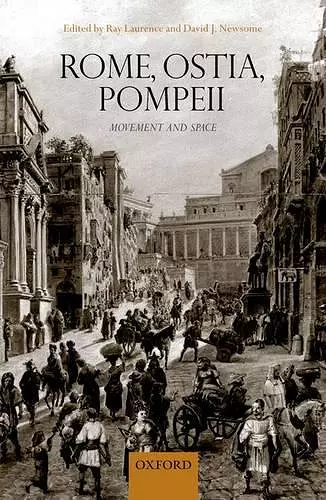Rome, Ostia, Pompeii: Movement and Space.
Ray Laurence editor David J Newsome editor
Format:Hardback
Publisher:Oxford University Press
Published:24th Nov '11
Currently unavailable, and unfortunately no date known when it will be back
This hardback is available in another edition too:
- Paperback£34.49(9780198707004)

Rome, Ostia, Pompeii: Movement and Space demonstrates how studies of the Roman city are shifting focus from static architecture to activities and motion within urban spaces. This volume provides detailed case studies from the three best-known cities from Roman Italy, revealing how movement contributes to our understanding of the ways different elements of society interacted in space, and how the movement of people and materials shaped urban development. The chapters in this book examine the impressions left by the movement of people and vehicles as indentations in the archaeological and historical record, and as impressions upon the Roman urban consciousness. Through a broad range of historical issues, this volume studies movement as it is found at the city gate, in public squares and on the street, and as it is represented in texts. Its broad objective is to make movement meaningful for understanding the economic, cultural, political, religious, and infrastructural behaviours that produced different types and rhythms of interaction in the Roman city. This volume's interdisciplinary approach will inform the understanding of the city in classics, ancient history, archaeology, and architectural history, as well as cultural studies, town planning, urban geography, and sociology.
This widely divergent collection of papers, contributed by an interdisciplinary group of scholars, is highly specialised although, as all the Latin quotations are translated, also accessible to academics in such fields as Cultural Studies, Town Planning, Urban Geography and Sociology, from which it derives much of its specialist terminology. But it does reward persistence with a very vivid vision of the teeming streets of ancient Roman towns. * Claire Gruzelier, Classics for All *
The editors and contributors are to be commended for pointing us in a new direction and restoring movement to our reconstructions of Rome. * Timothy O'Sullivan, Journal of Roman Studies *
will be of interest not only to students of the past but even to todays town planners ... opening a new historiography * Prof. Barbara Levick, Greece & Rome *
this is a very rich volume that scholars will want to read in its entirety. * Miko Flohr, The Classical Review *
This highly detailed and absorbing study crosses academic disciplines, is, as one would expect from its editors, thoroughly researched with an extensive bibliography, and is peppered with entertaining gems * Caitlin McCall, World Archaeology *
Each chapter has something to recommend it ... this is a beautifully produced book that moves its reader onto and through the streets of the Roman city. * Rebecca R. Benefiel, sehepunkte *
[the essays] maintain a high level of theoretical analysis and show thorough knowledge of both literary and archaeological sources ... A special feature is the bibliography, covering no fewer than 40 pages, and constituting a guide to the best work in Roman archaeology and social history in the last 100 years. A work of advanced scholarship for advanced scholars. * R. L. Frank, CHOICE *
The evidence, theories, and methodologies used by the contributors provide a synthesis demonstrating how further study of movement in the Roman world can aid in explaining cultural, social, political and economic change. * T.K. Henderson, Bryn Mawr Classical Review *
in presenting a broad collection of scholarship explicitly focused on movement, the editors have reinvigorated future research on space and movement and have proven its interdisciplinary applicability ... an ambitious and innovative collection of stimulating scholarship that is certain to have a considerable impact on the future of spatial studies and will clearly form a core text for both scholars and students of Roman urbanism for many years to come. * Michael A. Anderson, American Journal of Archaeology *
ISBN: 9780199583126
Dimensions: 241mm x 163mm x 28mm
Weight: 942g
464 pages